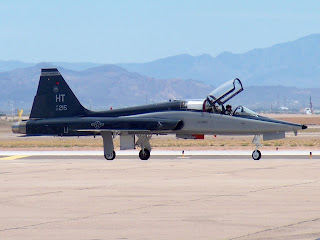Spotter guide to Northrop T-38 Talon
The Northrop T-38 Talon is
a twin-engine supersonic jet trainer. It was the world's first supersonic trainer and is
also the most produced.
Most
T-38s built were of the T-38A variant, but the USAF also had a small
number of aircraft that had been converted for weapons training. These aircraft
(designated AT-38B) had been fitted with a
gunsight and could carry a gunpod, rockets, or bombs on a centerline pylon.
T-38C to extend their service life to 2020. Improvements
include the addition of a HUD, GPS, INS (Inertial Navigation System), and TCAS as well as PMP (a propulsion modification to improve
low-altitude engine thrust). Many USAF variants (T-38A and AT-38B) are being
converted to the T-38C standard. The from the T-38A to the T-38C changes are the new Burner cans, the reshaped inlet. The NASA T-38N have a Radar that is not use by the USAF fleet.
T-38N : Two-seat astronaut
training version for NASA operates
a fleet of 32 T-38 aircraft and
uses the aircraft as a jet trainer for its astronauts, as well as a chase plane. Its fleet is housed
primarily at Ellington Field in Houston, Texas.





































